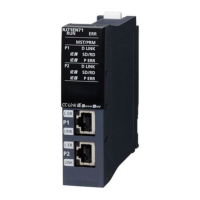1 FUNCTIONS
1.3 IP Packet Transfer Function
45
1
Use the same numbers for the first and second octets of the IP addresses of the request source device, request destination device, and modules between
them.
For the IP addresses of the Ethernet-equipped modules, set a number between 1 and 239 for the third octet and a number between 1 and 120 for the fourth
octet. The network number of the own station is automatically assigned to the third octet of the IP address of the master/local and remote head modules
each. The station number of the own station is automatically assigned to the fourth octet of the IP address of the master/local or remote head modules each.
(The fourth octet of the IP address of the master station is always 125.)
Use the same number for the third octet (network number) of the IP addresses of an Ethernet device and a Ethernet-equipped module connected to the
Ethernet device.
Do not use the third octet (network number) of the IP address same as that of other network modules and other CPU modules using the IP packet transfer
function.
*2 Do not use the same network numbers for those of network modules other than the master/local module.
The values in the first and second octets of the remote head module IP address are obtained from the master station IP address so that the same values as
those of the master station can be set.
192 . 168 . 10 . 36
The first and second octets (network addresses)
192 . 168 . 10 . 36
The third octet
The fourth octet
192.168.10.11 192.168.10.36
192.168.2.125 192.168.7.18
192.168. 2.8
Ethernet device
(request source device)
Network No.10
Network No.2
Ethernet-
equipped
module
Master
station
Station
No.0
Ethernet-
equipped
module
Local
station
Station
No.8
Local
station
Station
No.18
IP address setting
not required
192.168.10.1 192.168.21.2192.168.10.2 192.168.21.1
Ethernet
Ethernet
*2
EthernetCC-Link IE Field Network
Do not use the same network numbers for those highlighted.
Network No.10 Network No.21Network No.1
Network No.32
Network No.2

